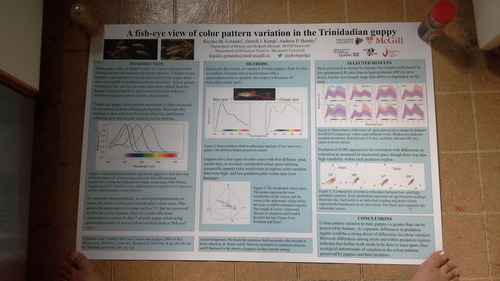by Kiyoko Gotanda
From July 31 to August 5th, over 1000 behavioural ecologists descended on Manhattan in New York City to attend the ISBE conference hosted by Hunter College, the City University of New York, and New York University. Conferences are a necessary component of academia allowing researchers to share their research, ask questions, and stay at the cutting edge of their field. While conferences are exciting and stimulating, they are also exhausting! However, the opportunity afforded by QCBS for me to attend ISBE was incredibly rewarding.
At ISBE, I presented a poster, only the second time I’ve ever done one! I think my poster introduction sums up the subject them well: “Male guppy color, an adaptive trait, is a classic example of the interaction between natural and sexual selection. Females favour brightly coloured males (sexual selection) but this makes them more susceptible to predation (natural selection). Colour pattern variation in this species has most often been studied from the human visual perspective, yet we now know that fish have different visual perception systems than humans. Traditional guppy colour pattern assessment is often conducted on an individual basis utilizing photographs. However, this method is often criticized for being subjective, and for not reflecting how fish actually perceive colour patterns. To overcome these problems, we used spectrophotometry to assess the relative reflectance of individual colour spots. This allows the assessment of colours such as UV that are perceived by fish but not by humans. Here we conduct the most comprehensive survey to date of male guppy colour using spectrophotometry to assess colour variation from a “fish-eye” view.”

What’s most interesting about guppies is that almost all their colour patches have a UV component to them, which the guppies can see, but humans cannot. This means that guppies can ‘see’ much differently than what we see. What does this mean? Well, at the moment, all I can tell you is there is a lot of variation in guppy colour when quantifying it from the perspective of other guppies, and predation appears to be a strong predictor of the variation. However, there is a lot of variation within a given predation regime, so I will be delving deeper to try and figure out the source(s) of that variation. The beauty of the conference and giving a poster presentation is that colleagues had all sorts of suggestions and idea in how to proceed.
ISBE was a wonderful opportunity to speak with a variety of researchers, especially those who are familiar with the visual perception and how it can vary based on the organism’s visual systems. I also got to attend a lot of other talks, and there were quite a few guppy researchers! For instance, I saw a presentation talking about how they were rearing guppies in different light environments to explore the carotenoid composition of colour patches.

Conferences are not cheap to attend as registration, transportation, lodging, and food can add up quite quickly! I was particularly interested in ISBE because I will be finishing my PhD soon (I hope!) and wanted to meet people to discuss ideas for potential post-docs. The award provided by QCBS allowed me to not only share my research and learn new things, but to network with potential post-doc supervisors and discuss research ideas. Merci, QCBS!

0 Comments